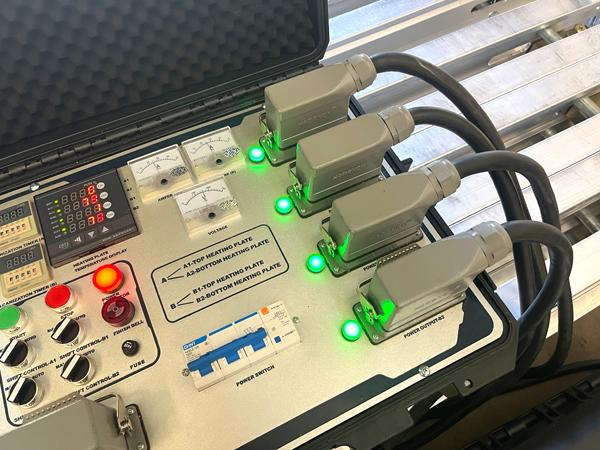The vulcanising stage of the conveyor splice is a critical step in achieving the best possible performance of the belt.
Precise control of curing time and temperature are necessary to guarantee optimal properties of the rubber and maximum splice life. If possible, a separate thermocouple unit, connected to a chart recorder or data acquisition unit, can be used to measure temperatures. However, most modern vulcanising presses have the functionality to connect to software that can plot the curing data.
"Vulcanizing should not begin until all thermocouple readings reach the specified temperature."
We recommend setting up a splicing shelter or tarpaulin to keep the splice dry and maintain consistent heat in adverse conditions like wind or rain, this ensures even heating across the press.
The splice and belt ends should be centred on the bottom platen, and kept 50mm to 100mm inside the platen edges. Do not shorten the splice length to fit the press without checking with the Belt manufacturer.
Choose the best vulcanising press to suit your needs, and ensure that it is capable of accommodating the required splice lengths for the belts that will be vulcanised.
Splice length guidelines are available for specific grades of belts, according to SANS (South Africa) and DIN (European) Standards. Or contact us if you need assistance.
When the cure is complete, the splice must cool to 55°C or lower before it is put into service. Leaving a splice in a hot vulcanising press while it cools without the aid of flushing water will result in over-curing the splice rubber. Always water cool the splice while the vulcanising press is still under pressure.
We don't recommend using a vulcanising press that does not have water cooling capabilities.
Careful monitoring and control of vulcanising parameters will ensure the splice achieves Ultimate Rubber Cure.
Chemvulc's range of heavy duty Vulcanising Presses made to your requirements and can be supplied with additional accessories for any conditions.
A Vulcanising Press made for you.
Contact us to discuss your requirements. We can build according to belt width, splice length, bias angle, voltage and also add-on equipment like splicing toolboxes, power, air and water supply.
